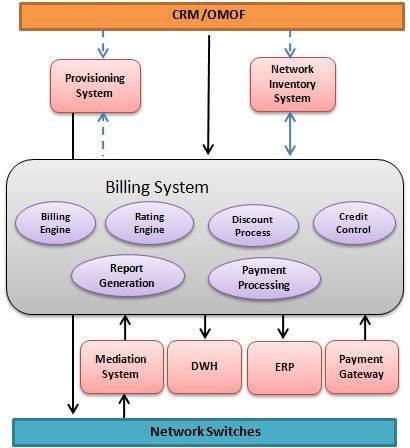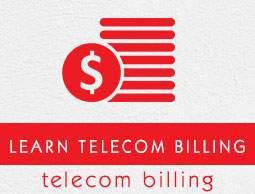Telecom Billing - System Architecture
The following diagram shows the typical architecture of a Billing System −

Here, we have two possibilities −
CRM (Customer Relationship Management)/OMOF (Order Management and Order Fulfilment) system contacts with the billing system and billing system contacts with provisioning system to provision the services and network inventory system as well to assign phone numbers or IP addresses, etc.
Second possibility could be that the CRM/OMOF system itself contacts with provisioning system to provision the services and network inventory system as well to assign phone numbers or IP addresses, etc.
Typical Billing Process
Considering the above system architecture: → After a call is made or you can say a usage is generated by the end customer, the mediation system gathers usage data from the network switch and builds a call-detail record (CDR). This CDR must contain 'A' party number and 'B' party number, the start and the end date & times.
The CDR is then stored until it can be rated. To rate the call, the CDR is examined to see if the call is, for example, an 800 number, a local call that is covered by a local-area calling plan, international call or a toll call. Information such as the time of the call was placed and city code or country codes are used to calculate the rate for the call.
Once each call is rated, this information is stored until the invoice is run, usually once a month. When the invoice is run, other nonusage charges, such as discounts or monthly fees, can be applied to the bill or sometime called invoice.
There could be a rating time discount or billing time discount, different payments done by the customers, different adjustments given, all these information contribute in the final invoice generation.
This information is then converted in a format, which can be printed in a readable form. Finally, the envelope is printed, stuffed with enclosures, and mailed to the end customer.
Billing System Requirements
A billing system should be composed of a series of independent applications that, when run together, are referred to as the billing system. A good billing system should provide the following major functionalities with a depth of flexibility −
Customer-interface Management − The billing system must be able to handle customer-initiated contact, oversee outbound customer contact, and manage the contact life cycle.
Order Management − It is a basic functionality, which should be available in a typical billing system. Billing system should be capable enough to capture product & service order and manage the order-entry life cycle, and oversee the order-completion life cycle.
Sales and Marketing − A satisfactory billing system should answer customer's query, handle commissions, provide sales support, track prospects, manage campaigns, analyze product performance, and acquire multiple dwelling units.
Rate Plans and Rating − A billing systems must manage a variety of products and services, different rate plans associated with those products and services and should provide flexible ways to rate usage generated by those products and services.
Discounting − A billing system should be capable of giving various types of discounts on different usages and rentals.
Invoicing − It is important that the system performs billing inquiry, generates bills, processes deposits, performs account administration, maintains tax and fee information, and processes financial information.
Credit Control & Collection − A billing system should control usage and revenue by assigning different credit classes to different customers. System should support payment collection and applying them on different invoices.
Multilingual Support − Multilingual support involves providing invoices and customer care services in multiple languages.
Multiple Currencies − Multiple currencies used in different countries can complicate the billing system as the billing and customer care system must be capable of recording and processing in units of multiple currencies.
Partner revenue management − Partner revenue management are the sharing of revenue between carriers that provide services to each other's customers.
Problem Handling − A billing system should also be able to manage trouble-ticket entry, coordinate trouble-ticket closure, and track the resolution progress of a trouble ticket.
Performance Reporting − A satisfactory system will provide performance reporting, ensure quality-of-service (QoS) reporting, create management reports, and generate regulatory reports.
Installation and Maintenance − The system should also provide workforce scheduling and manage activities performed at the customer premises.
Auditing & Security − A billing system should perform data audits and integrity checks. A secure system is always desirable for an operator.
Apart from the above functionalities, a good billing system should be −
Accelerating time-to-market for new service launches.
Enabling convergent view of customers and products.
Supporting cost-efficient architectural scalability.
Enabling partner relationship management and settlement.
Reducing total cost of ownership.
What is Next?
Starting from the next chapter, we would try to cover complete process starting from defining products and services, associating plan and tariffs with those products, acquiring customers (selling products to the end customers), capturing usage generated by those customers, and finally, rating and billing that usage to send a final bill to those customers.



